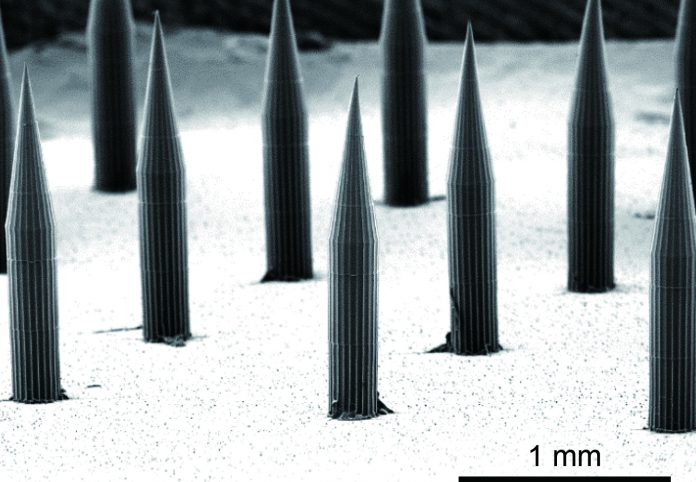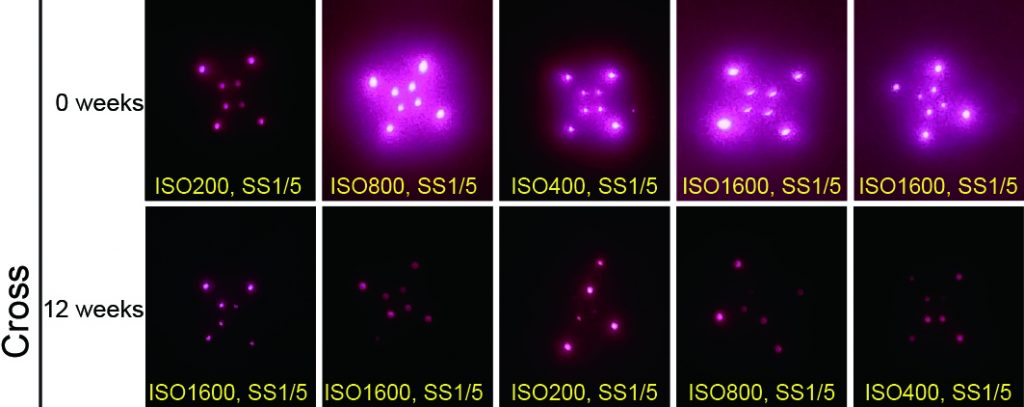
A close-up image of the microneedle array, which could delivery quantum dots into skin. [K.J. McHugh et al. Science Translational Medicine (2019)]
Researchers headed by a team at the Massachusetts Institute of Technology (MIT) have created a microneedle platform using fluorescent microparticles called quantum dots (QD), which can deliver vaccines and at the same time invisibly encode vaccination history directly in the skin. The quantum dots are composed of nanocrystals, which emit near-infrared (NIR) light that can be detected by a specially equipped smartphone. Tests using the platform showed that QDs delivered to samples of human skin were still detectable after photobleaching that simulated five years of exposure sunlight, and they remained detectable for up to nine months when tested in rats.

The researchers encapsulated their quantum dots in microspheres made of PMMA, a material that improves biocompatibility. [K.J. McHugh et al. Science Translational Medicine (2019)]
Experiments in live rats confirmed that the microneedle patches could also successfully deliver a polio vaccine at amounts generated therapeutic antibody levels. “It’s possible someday that this ‘invisible’ approach could create new possibilities for data storage, biosensing, and vaccine applications that could improve how medical care is provided, particularly in the developing world,” said senior researcher Robert Langer, PhD, the David H. Koch Institute professor at MIT. “This study confirmed that incorporating the vaccine with the dye in the microneedle patches did not affect the efficacy of the vaccine or our ability to detect the dye,” added Ana Jaklenec, a research scientist at MIT’s Koch Institute for Integrative Cancer Research. Langer and Jaklenec are co-corresponding authors of the team’s published paper in Science Translational Medicine, which is titled, “Biocompatible near-infrared quantum dots delivered to the skin by microneedle patches record vaccination.”
Vaccines save an estimated 2–3 million lives every year, but another 1.5 million vaccine-preventable deaths occur each year due to undervaccination, primarily in developing countries, the authors commented. One factor that makes vaccination campaigns in those nations more difficult is that there is little infrastructure for storing medical records, so there’s often no easy way to determine who needs a particular vaccine. The problem is compounded because many vaccines, such as the vaccine for measles, mumps, and rubella (MMR), require multiple doses spaced out at certain intervals. “In order to be protected against most pathogens, one needs multiple vaccinations,” Jaklenec said. “In some areas in the developing world, it can be very challenging to do this, as there is a lack of data about who has been vaccinated and whether they need additional shots or not.”
But these problems aren’t unique to the developing world. As the authors wrote, “… outbreaks of measles and mumps in the United States, Australia, and Italy have highlighted that poor immunization recordkeeping is not unique to developing nations.” Without accurate vaccination records, they pointed out, healthcare professionals don’t have all the data they need to make informed decisions about administering vaccines, and they may have to rely on parental recall. “This may result in the application of additional, unnecessary vaccine doses and therefore undue cost or, more problematically, missed opportunities to vaccinate, which leave the child at risk for contracting infectious diseases.”
Several years ago, the MIT team set out to devise a method for recording vaccination information in a way that doesn’t require a centralized database or other infrastructure. To create an “on-patient,” decentralized medical record, the researchers have now developed a new type of copper-based quantum dot, which emits light in the near-infrared spectrum. The dots are about 4 nm in diameter, and are encapsulated in biocompatible microparticles that form spheres about 20 µm in diameter. This encapsulation allows the dye to remain in place, under the skin, after being injected.
The researchers designed their dye to be delivered by a microneedle patch rather than using a traditional syringe and needle. Such patches are now being developed to deliver vaccines for measles, rubella, and other diseases. “By using a microneedle form factor, this platform should easily assimilate into the future vaccination landscape because microneedles are currently in development for several vaccines and have shown advantages such as antigen dose sparing, improved antigen stability, and ease of (self-)administration compared to traditional soluble injections,” the researchers commented.
Detection of the microdots is possible using specially adapted smartphones that can detect the near-infrared fluorescence. “Because these phones offer on-board processing power, camera applications, and inexpensive consumer-grade camera modules, we chose to adapt an existing smartphone to enable NIR imaging rather than build a completely new imaging system,” they wrote. “In addition, we believe that familiarity with the function of these devices will lessen the learning curve for NIR imaging in a field setting.”
The microneedles used in the reported study are made from a mixture of dissolvable sugar and a polymer called PVA, as well as the quantum-dot dye and, if appropriate, the vaccine. When the patch is applied to the skin, the microneedles, which are 1.5 mm long, partially dissolve, releasing their payload within about two minutes.
By selectively loading microparticles into microneedles, the patches deliver a pattern in the skin that is invisible to the naked eye but can be scanned with a smartphone that has the infrared filter removed. The patch can be customized to imprint different patterns that correspond to the type of vaccine delivered. Tests using human cadaver skin showed that the quantum dot patterns could be detected by smartphone cameras after five years of simulated sun exposure. The researchers also tested the vaccination strategy in rats, using microneedle patches that delivered the quantum dots along with a polio vaccine. They found that those rats generated an immune response similar to the response of rats that received a traditional injected polio vaccine. “ … the neutralizing antibodies achieved were well above the threshold considered protective by the U.S. Centers for Disease Control and Prevention,” the investigators stated.

The quantum dots after being administered to the skin of rodents. [KJ. McHugh et al. Science Translational Medicine (2019)]
The platform could feasibly provide clinicians with a more dependable way of keeping accurate medical records. “In areas where paper vaccination cards are often lost or do not exist at all, and electronic databases are unheard of, this technology could enable the rapid and anonymous detection of patient vaccination history to ensure that every child is vaccinated,” said Kevin McHugh, a former MIT postdoc who is now an assistant professor of bioengineering at Rice University.
The researchers plan to work with health care workers in developing nations in Africa to get input on the best way to implement this type of vaccination record keeping. They are also working on expanding the amount of data that can be encoded in a single pattern, allowing them to include information such as the date of vaccine administration and the lot number of the vaccine batch.
While the researchers believe that the quantum dots are safe to use in this way because they are encapsulated in a biocompatible polymer, further safety studies are planned before progressing to tests in humans. “In addition to the stand-alone value of an intradermal information encoding and detection platform, this system may offer greater advantages when co-delivered with vaccines,” they stated. “By delivering both agents in the same microneedle patch, there is the potential to realize production cost advantages and eliminate the possibility of misuse (such as applying the encoding patch without the vaccine) … Ultimately, we believe that this invisible, ‘on-body’ technology opens up new avenues for decentralized data storage and biosensing applications that could influence the way medical care is provided, especially in the developing world.”
SOURCE: GEN News
Posted by Cláudio H. Dahne (Biological Sciences - UFC)
Comentários
Postar um comentário